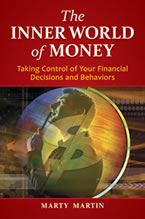Article first published as Book Review: The Inner World of Money: Taking Control of Your Financial Decisions and Behaviors by Marty Martin on Blogcritics.
July 13, 2012
The Inner World of Money:
Taking Control of Your Financial Decisions and Behaviors
Marty Martin
Praeger (2012)
ISBN: 9780313398247
New Book Offers Helpful Financial Behavior Questions & Answers
 Marty Martin’s The Inner World of Money is really a look at the inner world of people and their relationships with and beliefs about money. Rather than being a book about how to invest with explanations of stocks, bonds, and mutual funds, it explores the real role of money in our lives, the reasons for the roadblocks people create by being financially irresponsible, and whether money really can bring happiness. Ultimately, Martin shows readers that money has its place in our lives, a place we should not exaggerate, nor underestimate. We must not look to it for happiness, but we do need to be financially responsible, prepare for retirement, and understand the consequences when we do not.
Marty Martin’s The Inner World of Money is really a look at the inner world of people and their relationships with and beliefs about money. Rather than being a book about how to invest with explanations of stocks, bonds, and mutual funds, it explores the real role of money in our lives, the reasons for the roadblocks people create by being financially irresponsible, and whether money really can bring happiness. Ultimately, Martin shows readers that money has its place in our lives, a place we should not exaggerate, nor underestimate. We must not look to it for happiness, but we do need to be financially responsible, prepare for retirement, and understand the consequences when we do not.
The Inner World of Money is a great start for the person wanting a better understanding of money and its role in our lives and especially the person who has realized it is time to pay attention to finances, to quit struggling financially, and to begin saving for retirement. In addition, a helpful chapter is provided for parents about how to teach their children financial responsibility, including what lessons and information are appropriate to teach children at specific ages and stages of development.
With debt being a major concern among Americans today, Martin devotes a lot of space to consumerism, defining it as the buying of items that are not truly necessities, with the surprising statistic that 70 percent of what we spend our money on qualifies as consumerism. He offers practical advice for how to curb spending by discussing the difference between compulsive and impulsive buying and his 30-day and 24-hour rules for determining whether you really need or want something.
One of Martin’s insights about spending that I especially appreciated was the discussion of our digital lifestyle where credit cards have begun to take the place of cash. Martin advocates for paying cash whenever possible because credit cards make it easy to forget how much money we are spending or have, leaving us surprised when the credit card bills come in. But beyond this aspect of how technology has changed our relationship with money, he points out that while we own so many things we don’t need that many of us now have storage units, with the digital age, we can now house whole libraries and music collections on our digital devices, which means we don’t have to think about where we will find the space for everything we want to buy, a concern that in the past often helped to curb spending.
Martin also asks what he calls “stretch questions” to make us think about what truly makes us happy, what is really important, and what is the real place of money and possessions in our lives. In one of these powerful stretch questions, he uses the scenario of fleeing from a hurricane with only a car for transportation, to ask: “What would you pack if you had less than 12 hours to prepare your home for rain and 100 mph winds?”—remembering you may not have a home left when you return so anything you don’t pack you might lose forever. Most people would take their family members and then their pets, but that doesn’t leave room for much else. Items like children’s drawings usually win out over televisions. Asking yourself this question really helps to put things in perspective, and it’s just one of many similar insightful questions in the book.
An entire chapter is devoted to the role of happiness and myths about its relation to money, such as winning the lottery. Martin discusses how true happiness can come from being in control of our lives; we don’t feel such happiness when we are in debt, being tempted by consumer ads we can’t resist, or being owned by our possessions. He asks us to do a gratitude inventory of all the things that make us happy in our lives which also helps us to realize the role of money in relation to our happiness.
As a former clinical psychologist who is now a financial adviser/psychologist, Martin is well qualified to help his clients (and readers) understand the role of money in their lives, how to reduce their debt, and how to set financial goals. He is so dedicated to his work that he has even gone on “shopping tours” with some clients to understand what triggers them to buy specific items. Readers will be in good hands while reading this book. Anyone who wants to get a better handle on his or her relationship with money, so it serves its purpose in making our lives better without becoming our purpose in itself, will find this book of great value.
For more information about Marty Martin and The Inner World of Money, visit www.DrMartyMartin.com.
— Tyler R. Tichelaar, Ph.D., and author of the award-winning “Narrow Lives”

